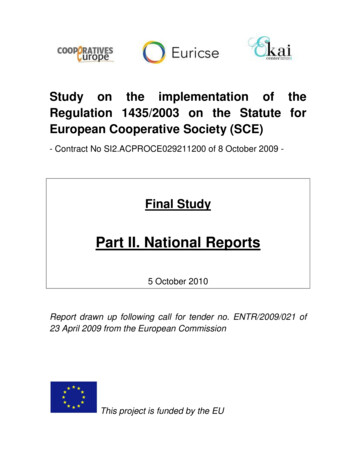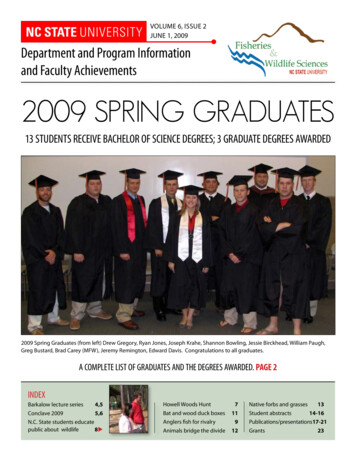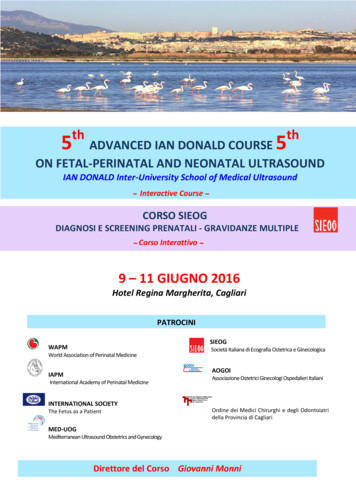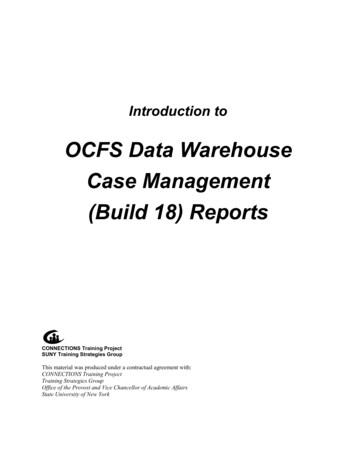
Transcription
Study on the implementation of theRegulation 1435/2003 on the Statute forEuropean Cooperative Society (SCE)- Contract No SI2.ACPROCE029211200 of 8 October 2009 -Final StudyPart II. National Reports5 October 2010Report drawn up following call for tender no. ENTR/2009/021 of23 April 2009 from the European CommissionThis project is funded by the EU
Study on the implementation of the Regulation 1435/2003 on the Statute for European Cooperative Society322
Part II. National ReportsCONTENTSAustria . 325Belgium. 343Bulgaria . 363Cyprus . 389Czech Republic. 405Denmark . 459Estonia . 491Finland . 507France . 519Germany . 547Greece . 587Hungary . 619Iceland . 631Ireland . 645Italy . 671Latvia . 703Liechtenstein . 721Lithuania . 731Luxembourg . 749Malta . 759Netherlands . 779Norway . 803Poland . 815Portugal . 837Romania . 855Slovakia . 867Slovenia . 877Spain . 895Sweden. 951United Kingdom . 971323
Study on the implementation of the Regulation 1435/2003 on the Statute for European Cooperative Society324
Part II. National Report: AUSTRIAAUSTRIABy Dietmar RoesslIn collaboration with Elisabeth ReinerSUMMARY. 1. The implementation of SCE Regulation 1435/2003 in Austrian legislation. – 1.1. Source, time andmodes of implementation. – 1.2. Structure and main contents of the national regulation on SCE. – 1.3. Thedesignated authority/ies as required by art. 78, par. 2, SCE Reg. – 1.4. Essential bibliography. – 2. A commenton the implementation of the SCE Regulation in Austrian legislation. – 3. Overview of national cooperative law.– 3.1. Sources and legislation features. – 3.2. Definition and aim of cooperatives. – 3.3. Activity. – 3.4. Formsand modes of setting up. – 3.5. Membership. – 3.6. Financial profiles. – 3.7. Organisational profiles. – 3.8.Registration and control. – 3.9. Transformation and conversion. – 3.10. Specific tax treatment. – 3.11. Existingdraft proposing new legislation. – 3.12. Essential bibliography. – 4. The SCE Regulation and national law oncooperatives. – 5. Annexes A) List of Abbreviations. – B) Partial translation of the most important provisions ofthe GenG.1. The implementation of SCE Regulation 1435/2003 in Austrian legislation1.1. Source, time and modes of implementationThe SCE Regulation has been implemented with the GenRAeG 2006, which waspublished on June 26, 2006, in the Austrian Bundesgesetzblatt, BGBl I No 104/2006. Itincludes the SCEG (law on SCEs) as a whole, as well as modifications of the existingfederal law on cooperatives. Furthermore, the GenRAeG 2006 provides other adaptationsthat are necessary in order to introduce the SCE into the existing body of Austrian law:These include amendments to the Gerichtsgebuehrengesetz (GGG; Court Fee Act), to theBankwesengesetz (BWG; Banking Act), the Versicherungsaufsichtsgesetz (VAG;Insurance Supervision Act) and to the Arbeitsverfassungsgesetz1 (ArbVG, Law Governingthe Employment System).Due to the regulations mentioned the formation of an SCE in Austria is possible sinceAugust 18, 2006.1.2. Structure and main contents of the regulation on SCEThe SCEG contains 33 sections and consists largely of references to national lawgoverning joint stock companies and cooperative societies. The SCEG for instanceregulates procedures for establishing an SCE, transferring the registered office of an SCE1The amendments to the ArbVG have been necessary for the implementation of the directive 2003/73/EG.325
Study on the implementation of the Regulation 1435/2003 on the Statute for European Cooperative Societyto another country and defines the possible management structures of an SCE. Themanagement functions of an SCE may be segmented into a Supervisory Board and aManagement Board (two-tier structure, dualistic governance structure) or may beexercised solely by an Administrative Board (one-tier structure, monistic governancestructure). For any matter on which there is no specific provision in Austrian law, theprinciples of the SCE Regulation apply.The council directive 2003/72/EC of July 22, 2003, was implemented by changing theArbeitsverfassungsgesetz (ArbVG).3261.3. The designated authority/ies, as required by article 78, par. 2, SCE RegSection 4 SCEG stipulates that for the addition of an SCE in the commercial registerand other matters named in articles 7, 29, 30, 54 para 2 and 73 of the regulation, thecourts of first instance for commercial matters are responsible.1.4. Essential bibliographyAustrian Financial Market Authority: Annual Report 2006; online available on:http://www.fma.gv.at/JBInteraktiv/2006/EN/500 text rechtsentwicklung nat.htm (accessed2009-12-29).Avsec, Franci: Die Europaeische Genossenschaft innerhalb des EuropaeischenWirtschaftsraumes (The SCE inside the european economic union), Marburger Beitraegezum Genossenschaftswesen 53, Marburg 2009.Dellinger, Markus: Was bringt das GenRAeG 2006? (What about the GenRAeG 2006?)ecolex 2006/570.Fiedler, Mathias: SCE-Gruendungserfahrungen in Deutschland (SCE-start-upexperiences in Germany), Neue Koelner Genossenschaftswissenschaft, Band 5/1,Muenster 2009, p. 132 – 140.Gruenwald, Alfons: SCE, AE, SME, SPE, FE – Neue Herausforderungen fuer daseuropaeische Gesellschaftsrecht (New challenges fort the european corporate law),GesRZ 2003, 252.Hable, Andreas: SCE – Neue Rechtsform fuer Unternehmen (SCE – A new legalstructure for companies); online available do (accessed 2009-12-30).Hofinger Hans/ Johler Christoph: Wettbewerb der genossenschaftlichen Rechtsformenin der SCE (Competition of cooperative legal forms in the SCE), Ziller-Schriften/ 3, OeGVVienna 2002.
Part II. National Report: AUSTRIAHofinger Hans/ Johler Christoph: Substanzbeteiligung in der EuropaeischenGenossenschaft (SCE) unter Beruecksichtigung nationaler Rahmenbedingungen(Participation in real value in the SCE with special focus on national provisions) , ZillerSchriften/ 5, OeGV Vienna 2005.Moser, Ingrid: Genossenschaftsrechtsaenderungsgesetz 2006 (Act AmendingCooperative Law 2006) ecolex 2006/467.OeGV booklet: SCE – A Comparison of the Implementation of EU Regulation No435/2003 on Cooperatives in National Law of the EU Member States and in National Lawof Non-EU Countries, CIBP, Vienna 2008.Legislative documents:ErlRV 1421 BlgNR XXII. GP; online available on:http://www.parlament.gv.at/PG/DE/XXII/I/I 01421/pmh.shtml (accessed 2009-12-02).ErlRV 467 BlgNR XXIII. GP; online available on:http://www.parlament.gv.at/PG/DE/XXIII/I/I 00467/pmh.shtml (accessed 2009-12-02).BGBl I No 104/2006.BGBl I No 70/2008.2. A comment on the implementation of the SCE Regulation in AustrianlegislationCurrently there is no SCE existing in Austria.This information is based on the interviews made and several phone calls with theFederal Ministry of Justice, which is the best official source of information in this regard. Itwas verified by an excerpt (December 2009) of the commercial register.According to the information available at present there is also no concrete plan forsetting up any SCE in the upcoming future.According to the national experts that were interviewed, the most important factor forthe fact that no SCE exists in Austria is the lack of necessity for the use of cooperatives incross border activities. Without a doubt the SCE in theory offers a huge potential, butcurrently there is not only a lack of publicity of the SCE regulation, but also no demand onthe ground.Cooperatives that are set up in Austria mainly act in a predominantly regional way,which has to be considered as one of the main reasons for their success, even in times ofdifficult economic environment2. Another crucial point might be that cooperatives2See Dellinger: Aktuelle Aenderungen im Genossenschaftsrecht (Current amendments to the GenG),Raiffeisenblatt 10/2006, online available on:http://www.raiffeisenblatt.at/eBusiness/rai template1/121810312645017022121809748930559302 126154437634825905-356740554811286736-NA-1-NA.html (accessed 2010-03-30).327
Study on the implementation of the Regulation 1435/2003 on the Statute for European Cooperative Society328traditionally are strongly linked with matters of identity (local, regional), what may bedifficult to facilitate in an SCE.3One possible area of application for SCEs might be for people/businesses located inborder areas. In such a case, the necessity of cross border activities obviously is almost agiven. Furthermore, it is of course obligatory to act in harmony with competition law, whichhas an especially important impact on big cooperatives with strong cross border activities– but competition law does not seem to prohibit the establishing of cooperatives.Furthermore, the back-office in the banking sector could be a possible field of application,as well as consultancy. One of the problems might be that the SCE does not offer anyobvious advantage compared to national cooperatives if there is not a lot of cross borderactivities.Potential stakeholders also shy away from being the frontrunner in starting up the firstSCE (in Austria). It would be of help if a huge SCE would be set up as a role model, whichthen could cause several articles in newspapers or on TV. Also a ―SCE homepage‖ withlegal information about starting up an SCE and about the particular cooperative law in theEU-member-states would be of help to support the SCE and cooperatives in general. Thepublic is not sufficiently informed about the legal form of the SCE, although there isinformation about most of the European legal forms available. Of course, the SCE is partof university education4, but in comparison to other forms of corporate law still with lowimportance. If the annual number of business start-ups is taken into account it is easilyunderstandable that the public attention tends to focus on other legal forms.5Furthermore, a point to bear in mind is that the implementation acts differ from countryto country, so that there are 27 possible types of SCEs in Europe. In this regard, theharmonization efforts only partially succeeded.6There are significant efforts though to enhance the publicity of SCEs in Austria. Thecooperative associations have media tools at their disposal. The journals ―cooperativ‖ and―Raiffeisenblatt‖ are used to inform a wider public about their activities and specificquestions concerning cooperatives. An interesting attempt to inform even a very youngaudience playfully about cooperatives has been the work-shop ―7 ZwergeGenossenschaft7‖ within the Vienna Summer University for Kids.8 Due to the success it ishighly probable that the workshop is going to take place again this summer.3It is interesting that the situation in Germany obviously is very similar to Austria. See Fiedler: SCEGruendungserfahrungen in Deutschland (SCE-start-up experiences in Germany), Neuer KoelnerGenossenschaftswissenschaft, Band 5/1, Muenster 2009, p. 140.4University of Vienna/ Department for co-operatives: Prof. Dr. Johann Brazda; WU Vienna University ofEconomics and Business/Resarch Institute for Co-operation and Co-operatives: Prof. Dr. Dietmar Roessl.5There are approximately 15 new cooperatives per year and e.g. 3.466 private limited companies (GmbHs).See the Statistical Yearbook of the Austrian Economic Chamber, chapter 17 (Start-ups of enterprises). Onlineavailable on:http://portal.wko.at/wk/format detail.wk?AngID 1&StID 357405&DstID 17 (accessed 2010-03-19).6See Dellinger (2006), p. 1.7―7 dwarfs cooperative‖. The workshop based on the fairy-tale „Snow white and the 7 dwarfs―. In Summer2009.
Part II. National Report: AUSTRIAPertaining to the legal side of the SCE it was feared that the implementation of theCommission Directive 2003/72/EC of 22 July 2003 – supplementing the Statute for aEuropean Cooperative Society with regard to the involvement of employees, made by anamendment of the Arbeitsverfassungsgesetz (ArbVG, Law Governing the EmploymentSystem) with articles 254ff – could be problematic. The regulations are very similar to theregulations concerning the involvement of employees in the SE. Because of these strongsimilarities to the SE regulation, the arrangement and the regulations of theimplementation itself were uncomplicated in the view of the Federal Ministry of Labour,Social Affairs and Consumer Protection (BMASK). The interviews exposed that theregulations about the involvement of employees do not constitute a dissuasive factor forthe establishment of SCEs in Austria. This is backed by the fact that in case of starting upan SCE by natural persons only or natural persons and one legal person and if there arenot more than 50 people employed, the provisions will not apply.Generally, the implementation act of the SCE regulation is considered as verysuccessful by the stakeholders. The fear that the SCE regulation and its implementationcould be too complex did not prove to be true.The major problems and counter-arguments for the foundation of an SCE in Austriabased on the research are the lacking necessity and the low level of information about theSCE among lawyers, corporate consultants and the potentially interested public.3. Overview of national cooperative law3.1. Sources and legislation featuresThe Austrian law concerning cooperatives, short GenG, was enacted in 1873.9 nossenschaftsrechtsaenderungsgesetz 2006(law changing the law concerningcooperatives) and the Unternehmensrechtsaenderungsgesetz 200811 (law changing thecorporate law).There are other collaterally laws as well as ordinances concerning cooperatives:Genossenschaftsrevisionsgesetz12 (Austrian Law concerning Cooperative Auditing)Verordnung ueber die Pruefungsordnung von Genossenschaftsrevisoren13(Ordinance concerning examination regulations for cooperative auditors)8For more information see Brazda/Blisse: Die Genossenschaft fuer Kinder erzaehlt (Cooperative narrated forkids) in cooperativ 2-3/09, p. 82, Vienna 2009.9RGBl 70/1873.10GenRAeG 2006; published in the Austrian Bundesgesetzblatt (Federal Law Gazette), BGBl I Nr. 104/2006.11URAeG 2008; published in the Austrian Bundesgesetzblatt (Federal Law Gazette), BGBl I Nr. 70/2008.12GenRevG.13GenRevPO.329
Study on the implementation of the Regulation 1435/2003 on the Statute for European Cooperative SocietyGenossenschaftsverschmelzungsgesetz14 (Law concerning the g15 (Ordinance concerning bankruptcycooperatives)ofof3.2. Definition and aim of cooperatives330Sect 1 para 1 GenG defines what cooperatives are (see page 19). The law is applicablefor associations of an unlimited number of members serving to support acquisitions andcommercial activities of their members.Since the enactment of the Unternehmensrechtsaenderungsgesetz 2008, the GenG(see sect 1 para 3) refers to the purposes mentioned in Art 1 para 3 of the regulation2003/1435/EC. Therefore, from that point on, cooperatives in Austria are able to pursuealso a social aim in explicit terms (until then it was also possible, but just implicitly). This isone of the main influences of the regulation 2003/1435/EG on the national law oncooperatives in Austria.3.3. ActivityCooperatives are able to pursue different activities. Sect 1 para 1 GenG enumeratessome examples for the possible economic nature of cooperatives: Loan-, Purchase-, Sale, Consume-, Utilization-, Exploitation-, Construction-, Residential- and EstablishmentCooperatives. In a legal regard this enumeration is not significant, since other types ofcooperatives like a Production Cooperative (Produktivgenossenschaft) might exist as well.The Wohnungsgemeinnuetzigkeitsgesetz (WGG – Law concerning the non-profitmaking of housing) contains some special regulations for Construction-, Residential- andEstablishing Cooperatives.Generally, all economic activities are permitted. There are only some specific lawswhich enforce a particular legal form for their members like article 12 Apothekengesetz(Pharmacist Law): The business of a pharmacy is possible in the legal form of apartnership in the way of the Unternehmensgesetzbuch16 (UGB – Business EnterpriseCode) or as a civil law association (GesBR – Gesellschaft buergerlichen Rechts17).Another example is article 22 of the notary code (Notariatsordnung – NO) which onlypermits the establishment of a General Partnership (Offene Gesellschaft – OG) or a14GenVerschmG.GenKonkVO.16Before the Handelsrechtsaenderungsgesetz 2005 (HaRAeG – Law changing the Commercial Code) 2005called Handelsgesetzbuch (HGB – Austrian Commercial Code). BGBl I 2005/120.17Sections 1175ff. Austrian General Civil Code (ABGB) stipulate the civil law association.15
Part II. National Report: AUSTRIAPartnership by Shares (Kommanditgesellschaft – KG) for a notary association. These rarerestrictions do not pose a disadvantage even considering that it is e.g. of course possiblethat several pharmacies start-up a purchasing cooperative.3.4. Forms and modes of setting upCooperatives in Austria are legal entities which arise by entry in the commercialregister18. A cooperative can be set up by at least two persons. Cooperative members joinby written declaration.For incorporation several things are obligatory:The firm name (Sect 3 para 1 subpara 1 GenG)The statutes in written form (Sect 3 para 1 subpara 2 GenG)The entry of the statutes in the commercial register (Sect 3 para 1 subpara 3GenG)The admission assurance to the appropriate auditing association (Sect 24GenRevG)3.5. MembershipThe necessary minimum number of members is two. The statute has to stipulate therequirements for the membership. Individuals as well as private or public legal entities andregistered partnerships are possible members of a cooperative. For admission, a writtendeclaration of accession is needed and their acceptance by the cooperative as well assigning at least one cooperative share.It is possible that the statutes tie the possible membership to certain personalrequirements like a special profession or the residence in a certain area. Since theGenRAeG 2006 investing members are allowed (Sect 5a para 2 subpara 1 GenG), ifstipulated by the statutes. New members have to achieve the special membershiprequirements of the statutes, sign a written declaration of accession which then has to beaccepted by the cooperative.3.6. Financial profilesBecause of the idea of an open membership there is no minimum capital and, exceptfor Construction-, Residential- and Establishing Cooperatives19, there is also no legal rule18The commercial register is a public index maintained by the regional courts (in Vienna by the CommercialCourt Vienna, in Graz by the Regional Court for Civil Affairs Graz).331
Study on the implementation of the Regulation 1435/2003 on the Statute for European Cooperative Societyconcerning the amount of the shares. Each member has to subscribe at least one share.But it is also possible – if regulated by the statutes – that the members sign more than oneshare, what also may have an impact on the voting rights. If there is a voting right definedby shares, it also can be limited. E.g. the maximum amount of a vote is 100, also if yousign more shares. The advantage of the voting right by shares is an incentive to sign moreshares what then increases the capital of the cooperative.3.7. Organisational profiles332The Austrian law on cooperatives stipulates two bodies that are obligatory: the GeneralAssembly and the Management Board. If the cooperative has at least 40 employees, aSupervisory Board is obligatory as well.20 Furthermore, each cooperative has to be amember in an auditing association (Revisionsverband).21 This is an advantage anddisadvantage of cooperatives simultaneously: On the one hand, the legally intended auditguarantees reliability for the cooperative members and their business partners. On theother hand though, in comparison to other legal forms the fees sometimes may cause aproblem, in particular for small cooperatives. Nevertheless, it has to be considered thateach legal form causes certain fees. E.g. most of the registered associations or companiesof limited liability also need cost-causing legal and tax advices or marketing consultancy,although they have not to be member to an association.The statutes have to stipulate the forms of notice of the General Assembly. E.g. it ispossible through a written invitation, email and announcements in newspapers. The periodfor the announcement must be appropriate. The cooperative agreement can stipulate a(limited) voting right by shares, or, otherwise, each cooperative member casts one vote22.If the voting right depends on other parameters (like the scope of delivery), it is necessarythat the principle of equality is maintained.23 The Management Board is elected by theGeneral Assembly or is nominated by the Supervisory Board (if there is one), if stipulatedby the statutes.24 Generally, only cooperatives member are able to be nominated.25 If alegal person is member of the cooperative since the URAeG 2008 it is possible to vote theperson who is authorized to represent the legal person. The Management Board consistsof at least one person. Their nomination can be revoked by the body of nomination19Sect 6 para 1 WGG. The minimum amount of the shares for Construction-, Residential- and EstablishingCooperatives is 218 .20Sect 24 para 1 GenG. Although a supervisory board is often not obligatory, the OeGV suggests establishingit anyway.21The Genossenschaftsverband (OeGV) and the Raiffeisenverband are the two most important auditingassociations for cooperatives in Austria.22Regardless of the numbers of shares the respective member holds.23Dellinger: Kommentar zum Genossenschaftsgesetz (Commentary on the Austrian Cooperative Society Act),Lexis Nexis, Vienna 2005, Sect 76.24Art 15 para 1 GenG.25Dellinger (2005), Sect 15, Rz 10.
Part II. National Report: AUSTRIA(General Assembly or Supervisory Board) at any time.26 It is very common that theManagement Board works honorary.3.8. Registration and controlCooperatives arise by entry in the commercial register. Therefore, a written cooperativecontract (statutes) is essential.27 Sect 5 GenG stipulates what the cooperative contractmust contain. Whereas the Austrian law also knows cooperatives with unlimited liability,right now there are only cooperatives with limited liability. Furthermore, each cooperativehas to be a member in an auditing association (Revisionsverband)28. See above, cap. 3.7.3.9. Transformation and conversionThe GenG does not include any specific rules or regulations on conversions. The Actabout the merger of cooperatives (Genossenschaftsverschmelzungsgesetz – GenVG)stipulates in Sect 1 para 1 GenVG that only the merger of cooperatives of the same liabilityis possible. Sect 9 – 11 GenVG stipulate that in the case of merger all members have aspecial ending-right.3.10. Specific tax treatmentThere is no specific tax regime for cooperatives in Austria. The cooperative profits aresubject to the corporation tax which is 25%. Contrary to limited-liability companies(GmbH), there is no minimum corporation tax for cooperatives if they take no profit.The taxation of the cooperatives members acts on the income tax (EStG) for naturalpersons29 or on the corporate income tax (KStG) for corporations.As described above, cooperatives are obliged to be member in an auditing association.A specific tax problem for cooperatives in Austria is the fact that it is impossible to getrecognised as being charitable in the meaning of the Bundesabgabenordnung (BAO –Austrian Federal Tax Code). E.g. limited-liability companies as well as registeredassociations are able to get the status of ―charitable‖ what means that they are exemptfrom paying corporation tax. This unequal treatment is hardly maintainable. It continues to26Sect15 para 2 GenG.Sect 2 para 1 subpara 2 GenG.28The Genossenschaftsverband (OeGV) and the Raiffeisenverband are the two most important auditingassociations for cooperatives in Austria.29If the donee is a natural person who keeps the cooperative share in her private property normally the incometax is compensated with the discount of the corporation tax.27333
Study on the implementation of the Regulation 1435/2003 on the Statute for European Cooperative Societybe a competitive disadvantage for the legal form of cooperatives. Currently, the FederalMinistry of Finance (BMF) takes the opinion that cooperatives are not able to be charitablebecause the principal object is the delivery of their members, which apparently isincompatible with the delivery of commonality in the meaning of article 35 BAO. Evenwhen it is now possible to start up a cooperative with social purposes it also should bepossible to be charitable in the way of the BAO.3343.11. Existing draft proposing new legislationActually there are no existing drafts proposing new legislation concerning cooperatives.Even the prospective amendments regarding the capital requirements for creditinstitutions could have an impact to cooperative equity.3.12. Essential bibliographyAustrian Economic Chamber: Statistical Yearbook 2009, Vienna 2009. Online availableon:http://portal.wko.at/wk/format detail.wk?AngID 1&StID 357405&DstID 17(accessed2010-03-19).Brazda Johann/ Blisse Holger: Die Genossenschaft fuer Kinder erzaehlt (Cooperativenarrated for kids) in cooperativ 2-3/09, S. 82, Vienna 2009.Dellinger, Markus: Kommentar zum Genossenschaftsgesetz (Commentary on theAustrian Cooperative Society Act), Lexis Nexis, Vienna 2005.Dellinger, Markus: Aktuelle Aenderungen im Genossenschaftsrecht (Currentamendments to the GenG), Raiffeisenblatt 10/2006. Online available on:http://www.raiffeisenblatt.at/eBusiness/rai template1/121810312645017022121809748930559302 (accessed 2010-03-30).Hofinger, Hans/ Hinteregger, Renate: Genossenschaften – Eine Perspektive fuerKommunen (Cooperatives – A chance for municipalities), in RFG 2007/3, Manz, Vienna2007.Hofinger, Hans/ Zawischa, Georg: Das Genossenschaftsrechtsaenderungsgesetz 2006(The GenRAeG 2006), in Die gewerbliche Genossenschaft 1/07, S. 30, Vienna 2007.Kalss, Susanne/Nowotny, Christian /Schauer, Martin (editors): OesterreichischesGesellschaftsrecht (Austrian Corporate Law), Manz, Vienna 2008.Keinert, Heinz: Oesterreichisches Genossenschaftsrecht (Austrian Cooperative Law),Manz, Vienna 1988.
Part II. National Report: AUSTRIA4. The SCE Regulation and national law on cooperativesThe GenRAeG 2006 among other things provides some adaptations that are necessaryin order to introduce the SCE into the existing bod
Bankwesengesetz (BWG; Banking Act), the Versicherungsaufsichtsgesetz (VAG; Insurance Supervision Act) and to the Arbeitsverfassungsgesetz1 (ArbVG, Law Governing the Employment System). Due to the regulations mentioned the formation of an SCE in Austria is possible since August 18, 2006. 1.2. Structure and main contents of the regulation on SCE











